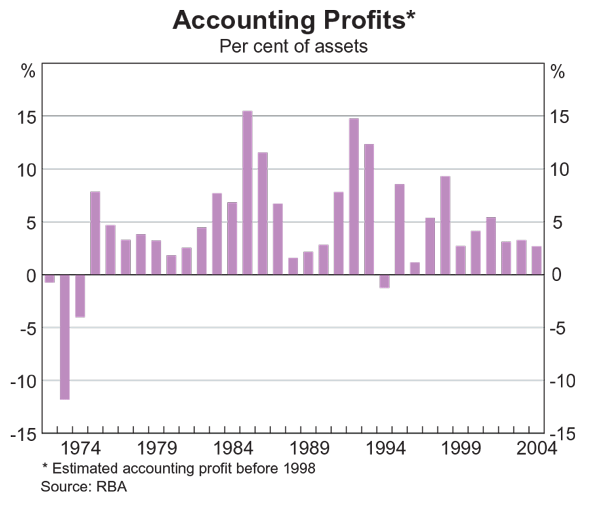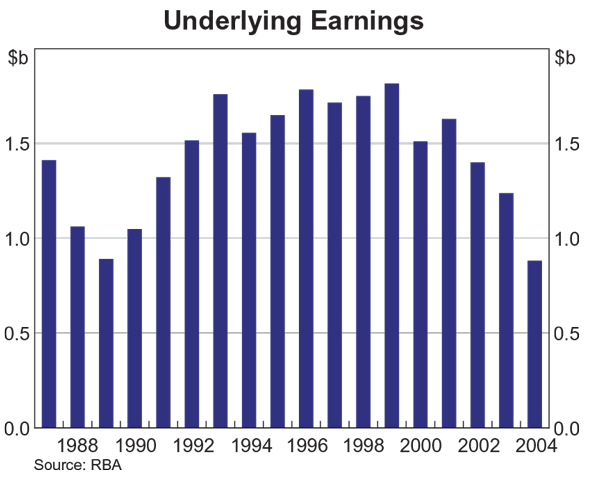Reserve Bank of Australia Annual Report – 2004 Earnings and Distribution
The RBA holds a substantial portfolio of financial assets for the purpose of undertaking operations to implement monetary policy. These assets are denominated both in Australian dollars and in the foreign currencies in which Australia's international reserves are invested. They provide two general sources of income – interest earnings plus valuation gains or losses. Valuation gains arise when market interest rates fall or, for foreign assets, when the Australian exchange rate depreciates; losses occur when interest rates rise or the Australian dollar appreciates. Valuation gains and losses are realised only when assets are sold.
Since 1998, the RBA has observed generally accepted accounting principles when preparing its financial statements so that its accounting profit is measured as earnings from all sources. However, because the RBA's operations are driven by policy considerations, it has virtually no scope to control the market risks that it faces on domestic assets, and only limited scope in the case of foreign assets. Consequently, accounting profits can be volatile as the value of its assets fluctuates with developments in financial markets. The volatility of accounting profits is shown in Graph 13. The influences on this pattern of profits were discussed in detail in the chapter on the ‘The Variability of Reserve Bank Profits’ in the Annual Report for 2003.

Although the RBA pays a dividend to the Government each year, only certain components of accounting profits are available for this distribution. Section 30 of the Reserve Bank Act 1959 determines that the sum available for distribution comprises underlying earnings, i.e. net interest earnings less operating costs, plus any realised valuation gains or losses. Unrealised valuation gains are not available to be distributed but are transferred to the Unrealised Profits Reserve, either to absorb future valuation losses or to be realised when relevant assets are sold.
Underlying earnings arise because the RBA does not pay interest on a large proportion of its liabilities, particularly currency in circulation and capital. By contrast, almost all of its assets earn interest. Underlying earnings in 2003/04 were $882 million, compared with $1,238 million in the previous financial year. This fall in underlying earnings reflected a combination of balance sheet and market developments. A key factor was the policy-driven decision to rebuild international reserves during the year, which led to a switch out of relatively high-yielding domestic assets into lower-yielding foreign assets. Interest earnings on foreign assets were also converted, on average, at an Australian dollar exchange rate higher than in 2002/03, a factor which worked to lower income measured in Australian dollar terms. Although the RBA now has a much larger portfolio of foreign assets, these positive ‘volume’ effects were not large enough to offset the negative ‘price’ effects of the switch from domestic assets to foreign assets.

The decline in underlying earnings in the past year continues the trend evident for a number of years. This reflects two major influences: firstly, the reduction in the level of interest rates around the world over the past decade; and secondly, the fact that the RBA pays interest on a higher proportion of liabilities than was once the case – interest is now paid on almost 40 per cent of total liabilities, compared with about 15 per cent a decade ago. This arises firstly because a higher proportion of its liabilities are term deposits from the Australian Government on which the RBA now pays interest, and secondly because certain liabilities on which it did not pay interest in the past – mainly deposits that commercial banks were required to hold at the RBA – have been abolished.
| Underlying earnings | Realised gains and losses | Earnings available for distribution | |
|---|---|---|---|
| 1986/87 | 1,412 | 2,035 | 3,447 |
| 1987/88 | 1,062 | 464 | 1,526 |
| 1988/89 | 891 | −474* | 417 |
| 1989/90 | 1,049 | 46* | 1,095 |
| 1990/91 | 1,322 | 391 | 1,713 |
| 1991/92 | 1,516 | 1,038 | 2,554 |
| 1992/93 | 1,760 | 2,803 | 4,563 |
| 1993/94 | 1,556 | −48* | 1,508 |
| 1994/95 | 1,649 | 123 | 1,772 |
| 1995/96 | 1,784 | 702* | 2,486 |
| 1996/97 | 1,715 | 1,990 | 3,705 |
| 1997/98 | 1,750 | 1,524 | 3,274 |
| 1998/99 | 1,816 | 1,860* | 3,676 |
| 1999/00 | 1,511 | −708 | 803 |
| 2000/01 | 1,629 | 1,205 | 2,834 |
| 2001/02 | 1,400 | 489 | 1,889 |
| 2002/03 | 1,238 | 1,159 | 2,397 |
| 2003/04 | 882 | −188 | 694 |
| * Includes unrealised losses in excess of previous years' unrealised gains held in reserves | |||
Looking at realised valuation effects, the RBA realised net losses of $188 million in 2003/04, compared with realised gains of $1,159 million in 2002/03. This shift from a position of substantial realised gain to a loss accounts for the bulk of the reduction in earnings available for distribution in 2003/04. The major part of this loss, some $279 million, came from losses on holdings of foreign bonds, as market interest rates overseas rose over the course of the year. The RBA also realised valuation losses of $63 million on domestic investments.
Notwithstanding the rise in the exchange rate, gains of $154 million were realised from foreign exchange sold from the portfolio at favourable exchange rates. The purchase of foreign exchange when the exchange rate was high in the March quarter resulted in large unrealised valuation gains as the exchange rate depreciated later in the year.
Earnings available for distribution – the sum of underlying earnings and realised gains – amounted to $694 million in 2003/04.
Accounting Profits
As noted, in accordance with generally accepted accounting principles, the RBA takes all valuation gains or losses – both realised and unrealised – to accounting profits. The losses realised in 2003/04 were smaller than unrealised gains so that total valuation gains amounted to $1,073 million. Adding these gains to underlying earnings results in total accounting profits in 2003/04 of $1,955 million (compared with $2,173 million in 2002/03).
Reserves and Dividend
Like other financial institutions, the RBA maintains reserves which are available to absorb potential future losses. The Reserve Bank Reserve Fund (RBRF), the major reserve, is available to cover potential losses from a range of risks, including market risk and other events, such as fraud and operational risks, to which most financial institutions are exposed in the course of their operations. The RBRF has been funded over time by transfers from earnings available for distribution and is akin to capital.
The Reserve Bank Act 1959 provides for the Treasurer to determine, after consultation with the Reserve Bank Board, the amount, if any, to be credited to the RBRF from earnings available for distribution. The balance of distributable earnings is payable to the Australian Government after any such transfers. At 30 June 2004, the balance of the RBRF stood at $6,285 million. As the Board regarded this balance as satisfactory, it did not approach the Treasurer for a transfer from profits in 2003/04. Accordingly, all of the earnings available for distribution in 2003/04 will be paid as a dividend to the Australian Government.
| Sum deferred from Earnings in 2002/03 (to be paid in 2004/05) | 964 |
|---|---|
| Plus | |
| Total Earnings Available from 2003/04 (payable in 2004/05) | 694 |
| Minus | |
| Earnings from 2003/04 deferred until 2005/06 | 320 |
| 1,338 | |
In recent years, the RBA has usually paid this dividend early in the financial year following that in which it was earned. Exceptions were in 1998/99 and 2002/03, when the Treasurer decided to defer part of dividend payable from profits from those years, spreading the payment over the following two years. In particular, the Treasurer deferred a sum of $964 million from the dividend earned in 2002/03 and decided that this should be paid in 2004/05. The Treasurer has again decided to delay receipt of part of the dividend due from earnings in 2003/04. A sum of $374 million was paid to the Government in August 2004, with a further $320 million to be paid in the 2005/06 year. Accordingly, the total payment made to the Australian Government in August 2004 amounts to $1,338 million; as illustrated in the table opposite, this payment comprises the sum deferred from 2002/03, plus earnings available for distribution in 2003/04 minus the sum deferred from those earnings until 2005/06.
In addition to the RBRF, the RBA maintains a number of other financial reserves. Under the Reserve Bank Act, and consistent with international practice for central banks, unrealised gains are not available to be paid but are transferred to the Unrealised Profits Reserve. Balances in this reserve remain available to absorb future unrealised losses that might arise from adverse movements in interest or exchange rates, or they are realised when relevant assets are sold. On 30 June 2004, the balance in the Unrealised Profits Reserve was $2,837 million.
| Payments to the Australian Government | |||||||
|---|---|---|---|---|---|---|---|
| Earnings available for distribution | Transfers to reserves | Balance available from current year's profit | Interim payment from current year's profit | Payment from previous year's profit | Payment delayed from previous year | Total payment | |
| 1990/91 | 1,713 | 210 | 1,503 | 400 | 275 | – | 675 |
| 1991/92 | 2,554 | 200 | 2,354 | 400 | 1,103 | – | 1,503 |
| 1992/93 | 4,563 | 750 | 3,813 | 600 | 1,954 | – | 2,554 |
| 1993/94 | 1,508 | – | 1,508 | – | 3,213 | – | 3,213 |
| 1994/95 | 1,772 | – | 1,772 | 200 | 1,508 | – | 1,708 |
| 1995/96 | 2,486 | 150 | 2,336 | 200 | 1,572 | – | 1,772 |
| 1996/97 | 3,705 | 2,005 | 1,700 | – | 2,136 | – | 2,136 |
| 1997/98 | 3,274 | 548 | 2,726 | – | 1,700 | – | 1,700 |
| 1998/99 | 3,676 | – | 3,676 | – | 2,726 | – | 2,726 |
| 1999/00 | 803 | – | 803 | – | 3,000 | – | 3,000 |
| 2000/01 | 2,834 | – | 2,834 | – | 803 | 676 | 1,479 |
| 2001/02 | 1,889 | – | 1,889 | – | 2,834 | – | 2,834 |
| 2002/03 | 2,397 | 133 | 2,264 | – | 1,889 | – | 1,889 |
| 2003/04 | 694 | – | 694 | – | 1,300 | – | 1,300 |
| 2004/05 | – | – | – | – | 374 | 964 | 1,338 |
| 2005/06 | 320 | ||||||
The RBA also maintains asset revaluation reserves, the balances of which reflect the amount by which the market value of its holdings of gold and property exceed the price at which they were purchased. At 30 June 2004, amounts in these reserves were $1,694 million, $181 million more than a year earlier.
The financial statements for 2003/04 are presented in the following pages.